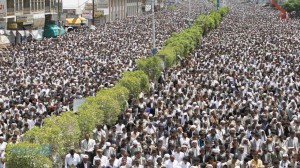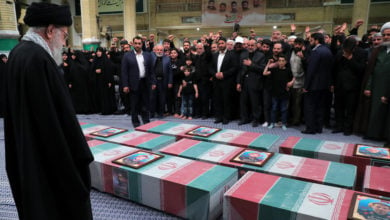
Given the limited quantity and quality of mainstream media reporting, a resident of the United States could be forgiven for having only a hazy idea of what and where Yemen is. Thus it’s not surprising that most people in the U.S. are unaware of the four-way power struggle that has been simmering there since the so-called Arab Spring in 2011, which led to the stepping down of long-time president Ali Abdullah Saleh. While the country has been immersed in first a three-way and now a four-way struggle since prior to 2011, the current four-way struggle has heated up considerably since the spring of 2014.
Historical background
Yemen is one of the poorest of the Arabic-speaking nations, yet with a population of 24 million, it is the most populous state in the Arabian Peninsula. It is also the most well-watered state in the Arabian Peninsula with not one but two rainy seasons. Parts of the Ta’izz province receive 40 inches of rain a year and parts of Ibb receive more than 50 inches of rain a year, comparable to famously rainy Seattle, Wash.
While it was originally supported by the Soviet Union and Nasser’s United Arab Republic against the royalists when the monarchy was overturned in 1962, the secular government based in the northern part of the country has increasingly become a U.S. client. This became clear in 1994 when the U.S. provided the north with critical aid and intelligence in the civil war that took place after the formerly Marxist part of the country in the south attempted to secede following the unification of the two parts of Yemen that occurred in 1990.
Parties to the four-way struggle
There has been an active four-way power struggle since 2011: the Herak in the south, the Houthis in the north, Al Qaeda in the Arabic Peninsula and the central government. No one current commands the loyalty of a clear majority. Two of the four players each has a defined geographic center where many of the residents support the aims of that movement.
The Herak: In the south, there still exists an active movement for independence or more autonomy for the former Peoples Democratic Republic of Yemen. This was where the Arab world’s only Marxist state existed prior to unification. This loose coalition of forces in the south includes all of the socialists and Marxists who are not in exile. They call themselves the Herak, which means “The Movement.” The Herak are homegrown and secular but have aligned themselves with all elements of the opposition. They might settle for a federation if the Houthis take power but are committed to some kind of more secular and socialist state. “In the mountainous region of Yafa—now termed the ‘Free South’ or الجنوبالحر—the rule of law is imposed by a network of tribes who have all pledged allegiance to the South Yemen Movement. Just minutes outside of Aden, flags of the former South Yemen can be seen raised in the open and graffitied upon many walls.”
Houthis: The home of the Houthi movement is in the far north of the country, bordering on Saudi Arabia and the Red Sea. The Houthis identify as Zaidi Shi’ites. This sect of Shi’ism only exists in Yemen and as many as 8 million Yemenis identify as being Zaidi. Sometimes this sect of Shi’ism is labeled as Fiver Imam Shi’ites to differentiate it from Twelver and Sevener Imam Shi’ism, which exist elsewhere. At first the Houthis were agitating for an autonomous region on the North Red Sea Coast and the mountainous agricultural regions bordering on Saudi Arabia in the northern part of the country. They felt left out of the economic advances with the discovery of natural gas in the eastern desert part of the country and the promise of perhaps some oil wealth if the border with Saudi Arabia should ever be agreed upon.
The Houthis, while homegrown, have been accused of receiving aid from Iran and Hezbollah in Lebanon. The Houthis deny receiving any such aid. Their power, support and influence seem to have grown tremendously in the last year or so. They appear to be ready to topple the current government. Their affinity with Iran and the likelihood of allying with Iran on the world stage means that the U.S. will try to intervene covertly, at least at first, to try and prevent this occurrence. The Houthis are Islamicists and want a nationalist, capitalist and theocratic state similar to what we see in Iran.
Central government: The U.S.-backed military elite are basically the same players as those who comprised the government that had been led by former President Ali Abdullah Saleh, who was deposed in 2012. The military today has all of the same officers who were loyal to Saleh. This military elite government has a direct link to the coalition of Arab nationalists who overthrew the Imamate in 1962 and then formed a unity government with what was left of the royalists in 1968. They have become increasingly more comprador and in the pocket of the U.S. defense establishment since they defeated the south’s attempt to secede from the unified Yemeni state in 1994. As was the case in Egypt, the U.S. government gave lip service to the popular democracy movement but did everything within their power behind the scenes to ensure that the existing pro-U.S. power structure remained in place. The compliant Yemeni military has cooperated with the U.S. military’s attacks on the fourth player on the scene, the Al-Qaeda in the Arabian Peninsula, or AQAP for short.
AQAP: AQAP has been the target of U.S. drone attacks that have killed at least two U.S. citizens in targeted assassinations. Many civilians have died in these drone attacks, and they are extremely unpopular. Sometimes, individuals have been targeted in cases of mistaken identity, and almost always there are innocent bystanders who get liquidated along with any alleged AQAP target. The AQAP for its part has carried out many attacks on the central government and claims to have some authority in some of the mountainous regions that lie on the site of the former border between north and south prior to unification.
AQAP opposes the socialists in the south and the Houthis in the north. According to U.S. intelligence sources as well as its own propaganda, the AQAP is part of a network that wants to set up a unified Islamic state comprised of all countries with a majority Muslim population. They want to separate completely from all non-Muslim influences and connections. If they were to pull this off, it would be called the 4th Caliphate. By all accounts, they are part of the network that was responsible for the September 11, 2001, attacks against the World Trade Center and the Pentagon. This Al-Qaeda network had its origins in the CIA-backed mujahadin that fought against the Soviet-backed socialist government in Afghanistan.
Recent events and the current situation
A June 22 Al-Jazeera article reports on a cease-fire agreement between the central government and the Houthi rebels after Houthi forces advanced to a farming villages 40 kilometers (24 miles) from the capital city Sana’a. This was the second truce in June.
On Aug. 17, thousands of Houthi supporters staged a demonstration in Sana’a to demand that fuel subsidies be reinstated. (Fuel subsidies are a sore point in Yemen. When this author was in Yemen in 1998, some fuel subsidies were removed and the cost of gasoline doubled. There were militant demonstrations at that time accompanied by burning car tires and large disciplined crowds marching on the Parliament building. The government responded with an armed military response. Some demonstrators were killed and the demonstrations stopped after about three days.)
Other demands include the resignation of the prime minister in President Hadi’s government and a more representative government that includes all political parties. Houthi leader Abdulmalek al-Houthi stated, “This government is a puppet in the hands of influential forces, which are indifferent to the rightful and sincere demands of these people,” an obvious reference to U.S. interference. (Al Jazeera)
On Sept. 9, pro-Houthi demonstrators tried to march on government buildings in central Sana’a. The army fired on the crowds and eight protesters were killed. Government sources claimed that some of the protesters fired on the army. According to Yemen Times, representatives from the Houthis and the government now are engaged in negotiations to end the current crisis.
Meanwhile, there have also been large demonstrations of as many as 100,000 people in Sana’a supporting the current government against the Houthis. Be that as it may, it is clear that there are also many who are disenchanted with the current government and its close ties with the U.S. In the most recent reports from Al-Jazeera, government forces have clashed with Houthi rebels in the capital near the TV station. The Yemeni air force has also attacked rebel positions in the province of Maarib with air strikes.
Even so, it appears that an agreement will be signed in the next couple of days for the prime minister to resign and be replaced by an appointed caretaker/technocrat prime minister and to slash fuel prices by 30 percent. This agreement will leave the current president, Abdrabuh Mansur Hadi, in power.
The latest reports by the AP indicate that non-governmental forces have clashed with Houthi forces in the north leaving at least 25 people dead in the wake of these battles.
Whichever way the situation plays out, several things are clear. The current weak central government could not last without the support of the military, which depends on U.S. backing for its existence. The U.S. ruling elite do not want to lose Yemen to an Iranian allied theocracy, or to have the AQAP build a stronger base in Yemen. They are perhaps even less inclined to allow an independent secular Marxist state in the south. So, they are forced to support an unpopular and by all accounts corrupt and undemocratic comprador government that was all but overthrown by a mass movement in February 2012. This mass movement would have succeeded in completely ousting the old regime had it not been for the “not so covert” U.S. intervention.
The U.S. drone attacks are very unpopular. All opposition forces call out the current government for being a puppet of the U.S. military establishment. The U.S. is correctly seen as the perpetrator of indiscriminate attacks that take out innocent bystanders without any apologies. It is also viewed and rightly so, as the supporter of the self-serving military elite in Yemen, who care more about their standing with the U.S. than the welfare of Yemenis. Yet the realities of maintaining an imperial presence in the Arabian Peninsula and economic control over the vast oil reserves in the region force the U.S. ruling class to keep Yemen weak, divided and separated from the sparsely populated Saudi Arabia, where those oil reserves are located. In contrast, the people of Yemen have shown that they have not given up on the promises offered by the Arab Spring. There is a strong groundswell that wants the current ruling establishment in Yemen to go away to be replaced by some entity that is more responsive to the needs and aspirations of the general population. Socialists should support the Yemenis’ right to decide their own destiny without the intervention of imperialism.
The current crisis could play itself out in the next couple of days, with a more or less static maintaining of the status quo accompanied by some meaningless crumbs tossed in the direction of the Houthi rebel movement. However, should the Houthi rebels gain further advantage against the U.S. client state’s military forces, we might be hearing more about the situation here in the U.S. It may well be that the current government could fall. It is not clear what would take its place. In this event, we will most likely be treated to a shrill chorus from CNN, NPR and Fox news singing a song in unison about the grave threat of the Iranian backed Shi’ites and/or AQAP and/or the socialists as a justification for air strikes or an even more ferocious rattling of the sabers to justify U.S. “boots on the ground.” U.S. military intervention in the Middle East has always been a disaster for the unfortunate recipients of such intervention. Furthermore, what right does the U.S. have to tell the Yemenis how to run their country? Should such events come to pass, we might all need to take a crash course in recent Yemeni history.






